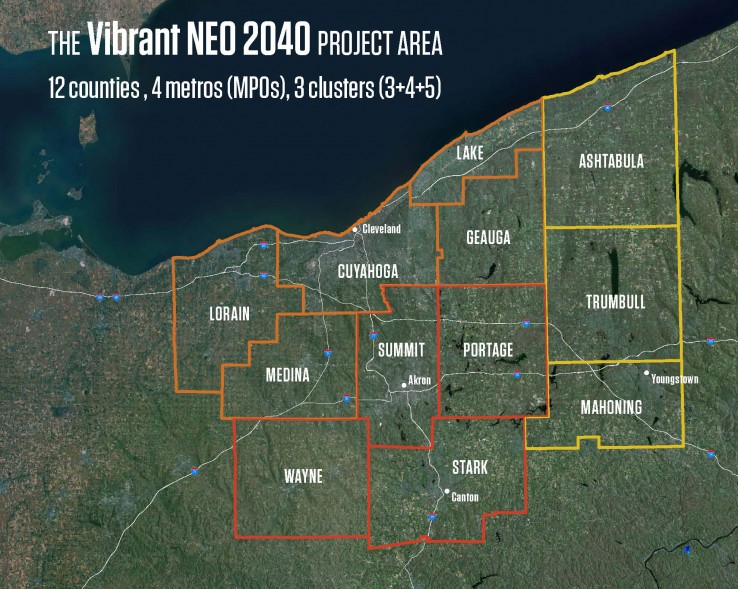On February 25, the NEOSCC Board voted unanimously to approve and endorse the Vibrant NEO 2040 Vision, Framework and Action Products. We are sharing an “Initiative A Day” so you can gain a better understanding of the vision and framework! If you would like to read all of the Initiatives, you can download them here: Recommendation and Initiatives. You can access a pdf of the entire vision chapter here. The vision chapter contains all 41 initiatives, development strategies, indicators, and matrices that identify how the recommendations, initiatives and indicators all relate.
Show your support for Vibrant NEO 2040 by adding your name to our Champions of Vibrant NEO 2040 list here.
Initiative 9.4: Align MPO/COG/ODOT transportation model inputs and continue to collaborate, share information, and align policy objectives across the multiple regional planning agencies of northeast Ohio.
WHAT THIS MEANS. The planning area in Vibrant NEO 2040 encompasses four transportation management areas (TMAs) served by four metropolitan planning organizations (MPOs). MPOs are federally-designated regional transportation planning entities charged with modeling transportation system performance and travel demand, maintaining a long range transportation plan for their TMA, and administering a Transportation Improvement Program through which federal transportation dollars flow to transportation project. Given the scope of MPOs’ duties, aligning transportation models, information systems, and policy objectives between these organizations is an important administrative step in making progress toward the region’s vision.
In other urban regions with several MPOs, an overarching coordination entity may exist to help align MPO’s modeling and planning efforts. The seven-MPO West Central Florida MPOs Chairs Coordinating Committee (CCC) in the Tampa Bay and central Gulf coast region is composed of the board chairpersons of each of its constituent MPOs, with nonvoting advisory representation from Florida Department of Transportation district secretaries, the area’s regional planning councils, and a non-governmental business-led transportation authority in the Tampa Bay area. The Committee develops a unified long-range transportation plan that helps to guide the updates of federally-endorsed long-range plans of member MPOs, organizes a regional congestion management system, and coordinates between member MPOs on major investment studies and project programming.
WHY THIS IS IMPORTANT. Today, there is not a formal overarching framework of coordination between Northeast Ohio’s MPOs. The multiple MPOs of the region may currently update long-range transportation models, plans, and transportation improvement programs on different cycles, may define differing selection criteria for projects to be included in the plans and programmed for funding, and may focus public outreach and comment on purely local issues due to their limited geographic scope. This may result in missed opportunities for combining efforts, programming projects, and developing policies that seek to achieve common objectives. It may also lead to major project investments that fail to yield the benefits and outcomes projected of them because they are not coordinated with other investments throughout the region and thus do not fully achieve their intended potential utility. Both of these in turn may hinder Northeast Ohio’s efforts at economic growth and development in the long term, especially as the region begins to draw on its collective strengths in keeping itself economically competitive.
GETTING IT DONE. Northeast Ohio’s MPOs should consider forming a coordinating council to align their activities and help ensure that truly regional projects and opportunities for investment are mutually understood. Ideally, this would further allow the coordinated planning and programming of projects to extend the benefits that an individual MPO’s investment of public funds would have for the entire region. An individual metropolitan area’s projects and programs could yield additional, region wide benefits if they were designed to complement one another and contribute to meeting the objectives for regional connectivity discussed in 5.1 and 5.2.
The council does not have to be large in size and may indeed be most effective when giving limited but strategic recommendations. Establishment of a coordinating committee for these MPOs can be an initial step in ensuring better coordination and making sure that transportation investments that benefit the larger region are mutually understood. It would specifically allow the following:
• Joint use of transportation models, with the possibility of integration into an overall regional travel demand model
• A focused audience for public comment on individual MPO LRTP drafts as they are being developed
• Real-time understanding of project demand from local governments throughout the region (as understood from MPO calls for projects)
• Potential combination/leverage of funds for technical assistance programs and other planning initiatives, especially related to Congestion Management and Air Quality (CMAQ)
| Lead | Metropolitan Planning Organizations, Councils of Governments |
| Target Community | Strategic investment areas, asset risk areas, cost risk areas |
| Implementation Complexity | Moderate |
These recommendations, initiatives, and products, are not one-size-fits all and some aspects of the initiatives won’t be applicable everywhere in the 12-county region. The Vibrant NEO 2040 Vision, Framework and Products are intended inspire and guide decision-making at the Metropolitan Planning Organization (MPO), Council of Government, and local levels to ensure that land use, transportation, and environmental considerations are simultaneously addressed by their processes. Ultimately, the implementation of Vibrant NEO 2040 is up to Northeast Ohio’s communities and residents. But regardless of the applicability of each initiative to any particular part of the region, the goal for each community within the Vision is the same: stability, prosperity, and a high quality of life for all of its residents.

